The Smart Money Loves These 10 Stocks
Post on: 22 Май, 2015 No Comment

During the past 10 years, the best hedge funds have consistently produced market-beating returns, driving huge capital inflows into the industry and making hedge funds one of the hottest investments on the Street.
Take John Paulson for example. The hedge-fund billionaire became a legend in 2008, when it was revealed he made billions for himself and his investors in 2007 after initiating huge short positions in housing stocks. He followed that up by shorting bank stocks in 2008, producing a 19% return for his investors while the S&P 500 continued to plummet.
David Einhorn has produced equally impressive results. Since launching Greenlight Capital in 1996, the fellow billionaire hedge-fund manager has produced an average annual return of 20%, crushing the S&P 500 and most of his hedge-fund competitors.
But unfortunately, most investors will never have access to these exotic investment vehicles.
Hedge funds are extremely exclusive investment instruments, offered only to accredited investors who have income of more than $250,000 and a net worth north of $1 million. Hedge funds are also insanely expensive. They frequently charge investors 2% of assets under management (AUM) and take 20% of annual profits, regardless of whether the fund outperforms the S&P 500. In addition, they also frequently have lock-in periods, preventing investors from accessing invested capital for years at a time. So even though the smartest money on the Street has a history of picking good stocks, access to institutional-class investments also comes with a few pitfalls.
That’s why I am such a big fan of tracking what these hedge funds own. Tracking institutional ownership is like having access to the smartest hedge funds in the world without having to pay a fee, give up any profits or participate in restrictive lock-in policies.
Big institutions such as hedge funds, mutual funds and endowments have better tools and information that enable them to sniff out big winners. They also frequently benefit from the momentum they create after buying huge blocks of stocks.
In the old days, tracking what hedge funds owned was hard to come by. It was either far too expensive for regular investors to access this information, or it would be buried in a pile of paperwork from the U.S. Securities and Exchange Commission. intimidating even the most seasoned forensic accountant. But through advancements in technology, this kind of information is now easily accessed through public channels such as Reuters or Bloomberg.
And that’s exactly how I recently come up a list of the 10 stocks with the highest level of institutional ownership in the S&P 500.
Top 10 Smart-Money Stocks on S&P 500
Of these 10 stocks, two stand out as my favorites. Here they are.
1. Gilead Sciences Inc. (Nasdaq: GILD )
1-year gain: 72.8%
Institutional ownership: 98.94%
This biotechnology company specializes in developing therapeutics for the treatment of life-threatening diseases such as HIV and hepatitis B. The company is also massive, with a market cap of $59 billion. But that hasn’t stopped smart money from loading up on shares. with a staggering 98.9% institutional ownership.
This interest from the biggest investors on the Street has lifted Gilead to an amazing 72.8% gain in the past year and 112% in the past two. But in spite of these gains, shares still look undervalued, trading with a forward price-to-earnings ( P/E ) ratio of just 20, well below its 10-year average P/E of 25 and industry P/E average of 35.

2. Priceline, Inc. (Nasdaq: PCLN )
Market Cap: $32 billion
1-Year Gain: 34%
Institutional ownership: 98.91%
Priceline, an online travel deals specialist, has been another high flyer, up 34% in the past year and 48% in the last two. This bullish movement has been fueled by strong interest from the smartest money on the Street, with institutional ownership clocking in at an impressive 98.8%. But like Gilead, Priceline is an earnings powerhouse, with analysts projecting full-year earnings of $35.95 per share in 2013.
So in spite of its nominally high share price currently hovering around $650, Priceline is trading with a price-to-earnings/growth ( PEG ) ratio of just 0.8, safely below the benchmark of 1 for value.
Risks to Consider: Big institutional investors can move stocks higher, but if they lose interest in a particular stock and rotate into new ideas that high volume selling can weigh on shares.
Action to Take —> These 10 stocks have the highest institutional ownership in the S&P 500. This means the smartest money on the Street thinks shares are set to move higher, giving investors an opportunity to cash in on more bullish movement. But out of the group, Priceline and Gilead also look undervalued relative to historic levels and their peers in spite of bullish earnings projections going into 2013. That should provide extra support these two stocks.
P.S. — It’s finally here. our Top 10 Stocks for 2013 . Since we first began publishing this annual report in 2003, our picks have beaten the market 7 out of the past 9 years. including average annual gains of up to 38.7% in a single year. Go here to learn more.














